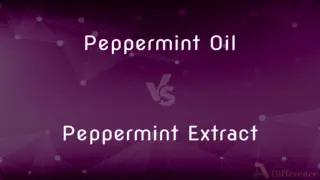Inox vs. Stainless Steel — What's the Difference?
By Tayyaba Rehman — Published on January 9, 2024
Inox is another term for stainless steel, a corrosion-resistant alloy. They refer to the same material.

Difference Between Inox and Stainless Steel
Table of Contents
ADVERTISEMENT
Key Differences
Inox, short for "inoxidable," is a term commonly used in some languages for stainless steel. Stainless steel is an iron alloy known for its resistance to rust and corrosion.
Both inox and stainless steel are composed of iron, chromium, and often nickel, which give them their anti-corrosive properties. There is no difference in composition.
Inox is particularly used in European languages, while stainless steel is the term predominantly used in English-speaking countries. They are synonymous.
The terms inox and stainless steel both refer to the same range of alloys, used in various applications due to their durability and resistance to corrosion.
In different contexts, whether it’s inox or stainless steel being used, the reference is to a material that combines aesthetic appeal with practicality, often used in kitchenware, construction, and medical instruments.
ADVERTISEMENT
Comparison Chart
Definition
Another name for stainless steel.
An iron alloy with chromium, resistant to corrosion.
Language Usage
Common in European languages.
Predominantly used in English-speaking countries.
Composition
Iron, chromium, and often nickel.
Same as inox.
Corrosion Resistance
High resistance to rust and corrosion.
Same as inox.
Applications
Kitchenware, construction, medical tools.
Same as inox.
Compare with Definitions
Inox
A mixture of metals.
Inox is an alloy of iron and chromium.
Stainless Steel
Offers a sleek appearance.
The stainless steel appliances modernized the kitchen.
Inox
Inox is stainless steel.
The inox cutlery looked brand new.
Stainless Steel
Resists rusting and staining.
Stainless steel utensils are easy to clean.
Inox
Used in various applications.
Inox fixtures are popular in modern homes.
Stainless Steel
Known for strength and longevity.
Their stainless steel sink resisted scratches.
Inox
Known for its durability.
Their inox appliances lasted for years.
Stainless Steel
Used in many industries.
Stainless steel is common in medical devices.
Inox
Resistant to rust.
The inox railing withstands harsh weather.
Stainless Steel
Contains iron and chromium.
Stainless steel is a strong material for construction.
Inox
(attributive) stainless steel
Inox steel
Stainless Steel
Alternative spelling of stainless steel
Common Curiosities
What is Stainless Steel?
A corrosion-resistant iron alloy.
Is Inox Different from Stainless Steel?
No, they refer to the same material.
What Makes Stainless Steel 'Stainless'?
Its chromium content prevents rusting.
Can Inox Rust?
Under extreme conditions, it can, but it's generally rust-resistant.
What's the Main Use of Inox?
In kitchenware, architecture, and medical equipment.
Why is it Called Inox?
Short for "inoxidable," meaning non-oxidizable.
Is Stainless Steel Expensive?
It's moderately priced, depending on the grade.
What is Inox?
Inox is another term for stainless steel.
How is Stainless Steel Made?
By alloying iron with chromium and other elements.
Is Stainless Steel Recyclable?
Yes, it's highly recyclable.
Why Choose Inox for Kitchenware?
For its durability and rust resistance.
How Do I Clean Stainless Steel?
With mild detergent and water, avoiding abrasives.
Are There Different Types of Inox?
Yes, like 304 and 316, with varying properties.
Is Inox Magnetic?
Some grades are, while others like 316 are not.
Can Stainless Steel Be Painted?
Yes, but it requires specific preparation and paint.
Share Your Discovery

Previous Comparison
Progressively vs. Slowly
Next Comparison
Peppermint Oil vs. Peppermint ExtractAuthor Spotlight
Written by
Tayyaba RehmanTayyaba Rehman is a distinguished writer, currently serving as a primary contributor to askdifference.com. As a researcher in semantics and etymology, Tayyaba's passion for the complexity of languages and their distinctions has found a perfect home on the platform. Tayyaba delves into the intricacies of language, distinguishing between commonly confused words and phrases, thereby providing clarity for readers worldwide.













































